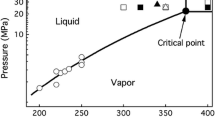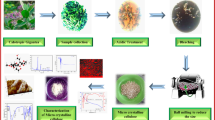Abstract
A detailed physico-chemical characterisation of potential new cellulose sources (rice husk, hemp stalk, and coniferous needles), and microcrystalline cellulose (MCC) manufactured from them, was made in this work. The length and the width of the cellulose crystallites were determined by wide-angle X-ray scattering (WAXS), crystallinities were studied by means of WAXS and solid state cross polarisation magic angle spinning 13C nuclear magnetic resonance (NMR) spectroscopy, and the packing and the cross-sectional shape of the microfibrils were determined by small-angle X-ray scattering. When MCC was prepared from rice husks and hemp stalks an acceptable yield was obtained. Crystallinities obtained with solid state NMR spectroscopy and WAXS were highest for MCC prepared from hemp stalks, and lowest for rice husk MCC. The crystallite sizes of MCC samples studied in this work varied more than in those MCC samples which were prepared from conventional plant sources, and crystallite size and cellulose crystallinity were related. When taking into account rather high values of specific surface, hemp stalks and rice husks appear as a promising raw materials for MCC production.










Similar content being viewed by others
References
Abe K, Yano H (2009) Comparison of the characteristics of cellulose microfibril aggregates of wood, rice straw and potato tuber. Cellulose 16:1017–1023
Andersson S, Serimaa R, Torkkeli M, Paakkari T, Saranpää P, Pesonen E (2000) Microfibril angle of Norway spruce [Picea abies (L.) Karst.] compression wood: comparision of measuring techniques. J Wood Sci 46:343–349
Andersson S, Serimaa R, Paakkari T, Saranpää P, Pesonen E (2003) The crystallinity of wood and the size of cellulose crystallites in Norway spruce (Picea abies). J Wood Sci 49(6):531–537
Andersson S, Serimaa R, Väänänen T, Paakkari T, Jämsä S, Viitaniemi P (2005) X-ray scattering studies of thermally modified Scots pine (Pinus sylvestris L.). Holzforschung 59:422–427
Battista J (1975) Microcrystal polymer science. McGraw-Hill, New York
Beckermann G, Pickering K (2008) Engineering and evaluation of hemp fibre reinforced polypropylene composites: fibre treatment and matrix modification. Compos A 39:979–988
Di Guardo A, Zaccara S, Cerabolini B, Acciarri M, Terzaghi G, Calamari D (2003) Conifer needles as passive biomonitors of the spatial and temporal distribution of DDT from a point source. Chemosphere 52:789–797
Efremova SV, Korolev YM, Sukharnikov YI (2008) X-ray diffraction characterization of silicon–carbon nanocomposites produced from rice husk and its derivatives. Chem Technol 419:78–81
Eichhorn S, Dufresne A, Aranguren M, Marcovich N, Capadona J, Rowan S, Weder C, Thielemans W, Roman M, Renneckar S, Gindl W, Veigel S, Keckes J, Yano H, Abe K, Nogi M, Nakagaito A, Mangalam A, Simonsen J, Benight A, Bismarck A, Berglund L, Peijs T (2010) Review: current international research into cellulose nanofibres and nanocomposites. J Mater Sci 45:1–33. URL:10.1007/s10853-009-3874-0
Feigin L, Svergun D (1987) Structure analysis by small angle X-ray and neutron scattering. Plenum Press, New York
Green JW (1963) Methods in carbohydrate chemistry, iiird edn. Academic Press, New York
Haworth DT, Zetlmeisl MJ (1968) Thin-layer chromatography of some inorganic complexes using microcrystalline cellulose as the separation medium. Sep Sci Technol 3(2):145–150
Jakob H, Fengel D, Tschegg S, Fratzl P (1995) The elementary cellulose fibril in Picea abies: comparison of transmission electron microscopy, small-angle X-ray scattering and wide-angle X-ray scattering results. Macromolecules 28:8782–8787
Jakob H, Tschegg S, Fratzl P (1996) Hydration dependence of the wood-cell structure in Picea abies: a small-angle scattering study. Macromolecules 29:8435–8440
Jenkins B, Baxter L, Miles T (1998) Combustion properties of biomass. Fuel Process Technol 54(1–3):17–46
Knaus S, Bauer-Heim B (2003) Synthesis and properties of anionic cellulose ethers: influence of functional groups and molecular weight on flowability of concrete. Carbohydr Polym 53(4):383–394. doi:10.1016/S0144-8617(03)00106-1, URL: http://www.sciencedirect.com/science/article/B6TFD-48R1WR5-1/2/485a3eecb1216f980075a8f12e66e33c
Kotelnikova N, Fengel D, Kotelnikov V (1994) Electron microscopic visualization of existence of weak bonds in cellulose. In: Prepr. of Kyoto Conference on Cellulose, p 64
Kurschner K, Popik M (1962) Zur analyse von holzern. Holzforschung 16(1):1–11
Leppänen K, Andersson S, Torkkeli M, Knaapila M, Kotelnikova N, Serimaa R (2009) Structure of cellulose and microcrystalline cellulose from various wood species, cotton and flax studied by X-ray scattering. Cellulose 16(6):999–1015
Levis SR, Deasy PB (2001) Pharmaceutical applications of size reduced grades of surfactant co-processed microcrystalline cellulose. Int J Pharm 230(1–2):25–33. doi:10.1016/S0378-5173(01)00843-2, URL: http://www.sciencedirect.com/science/article/B6T7W-44724PW-3/2/0b3b7fa91b51a1734cd7022b64b75a5c
Liitiä T, Maunu SL, Hortling B, Tamminen T, Pekkala O, Varhimo A (2003) Cellulose crystallinity and ordering of hemicelluloses in pine and birch pulps as revealed by solid-state NMR spectroscopic methods. Cellulose 10:307–316
Liou TH, Chang FW, Lo JJ (1997) Pyrolysis kinetics of acid-leached rice husk. Ind Eng Chem Res 36:568–573
Lovchikova L, Nikonenko S, Plyuta V, Sergeichik S (1997) Spectral reflection characteristics of spruce needles and leaves of trees in the zones with industrially polluted air. J Appl Spectr 64(6):804–808
Marshall K, Sixsmith D (1974) Some physical characteristics of microcrystalline cellulose 1. Powders for pharmaceutical use. Drug Dev Ind Pharm 1(1):51–71. doi:10.3109/03639047409088168, URL: http://informahealthcare.com/doi/abs/10.3109/03639047409088168, http://informahealthcare.com/doi/pdf/10.3109/03639047409088168
Maruska A, Liesiene J, Serys A (1996) Regulation of cellulose based adsorbent granule morphology. J Chromatogr A 746:147–160
Matsuoka H, Tanaka H, Hashimoto T, Ise N (1987) Elastic scattering from cubic lattice systems with paracrystalline distortion. J Am Phys Soc 36(3):1754–1765
McTiernan KB, Coûteaux MM, Berg B, Berg MP, de Anta RC, Gallardo A, Kratz W, Piussi P, Remacle J, Santo AVD (2003) Changes in chemical composition of Pinus sylvestris needle litter during decomposition along a European coniferous forest climatic transect. Soil Biol Biochem 35(6):801–812. doi:10.1016/S0038-0717(03)00107-X, URL: http://www.sciencedirect.com/science/article/B6TC7-4875VVM-1/2/64094926b24f898960012ca57ec3c0ba
Moon RJ, Martini A, Nairn J, Simonsen J, Youngblood J (2011) Cellulose nanomaterials review: structure, properties and nanocomposites. Chem Soc Rev 40:3941–3994. doi:10.1039/C0CS00108B, URL:http://dx.doi.org/10.1039/C0CS00108B
Newman RH (1999) Estimation of the relative proportions of cellulose Iα and Iβ in wood by carbon-13 nmr spectroscopy. Holzforschung 53(4):335–340
Obolenskaya AV, Shchegolev VP, Akim GL, Akim E, Kossovich NP, Emel’yanova IZ (1965) Practical works on chemistry of wood and cellulose. Forest Industry, Moscow
O’Donnell A, Dweib M, Wool R (2004) Natural fiber composites with plant oil-based resin. Compos Sci Technol 64:1135–1145
Okahisa Y, Yoshida A, Miyaguchi S, Yano H (2009) Optically transparent wood-cellulose nanocomposite as a base substrate for flexible organic light-emitting diode displays. Compos Sci Technol 69(11–12):1958–1961. doi:10.1016/j.compscitech.2009.04.017, URL: http://www.sciencedirect.com/science/article/B6TWT-4W6Y851-3/2/3fd92d80172fa4e74af0601a9d25c46f, experimental techniques and design in composite materials (ETDCM8) with regular papers
Ouajai S, Shanks R (2005) Solvent and enzyme induced recrystallization of mechanically degraded hemp cellulose. Cellulose 13:31–44
Penttilä PA, Várnai A, Leppänen K, Peura M, Kallonen A, Jääskeläinen P, Lucenius J, Ruokolainen J, Siika-aho M, Viikari L, Serimaa R (2010) Changes in submicrometer structure of enzymatically hydrolyzed microcrystalline cellulose. Biomacromolecules 11(4):1111–1117. doi:10.1021/bm1001119, URL: http://pubs.acs.org/doi/abs/10.1021/bm1001119, pMID: 20329744, http://pubs.acs.org/doi/pdf/10.1021/bm1001119
Petropavlovsky G, Kotelnikova N (1985) Phenomenological model of the fine structure of native cellulose based on the study of heterogeneous and homogeneous destruction. Acta Polymerica 36(2):118–123
Rydholm SA (1965) Pulping processes. Interscience Publishers, New York
Sanguansri P, Augustin MA (2006) Nanoscale materials development—a food industry perspective. Trends Food Sci Technol 17(10):547–556. doi:10.1016/j.tifs.2006.04.010, URL:http://www.sciencedirect.com/science/article/B6VHY-4K0D7WR-1/2/dee171d8e3796d61a0859e23344ad50f
Siriwardena S, Ismail H, Ishiaku U, Perera M (2002) Mechanical and morphological properties of white rice husk ash filled polypropylene/ethylene-propylene-diene terpolymer thermoplastic elastomer composites. J Appl Polym Sci 85(2):438–453
Sivonen H, Nuopponen M, Maunu SL, Sundholm F, Vuorinen T (2003) Carbon-thirteen cross-polarization magic angle spinning nuclear magnetic resonance and fourier transform infrared studies of thermally modified wood exposed to brown and soft rot fungi. Appl Spectrosc 57(3):266–273. URL:http://as.osa.org/abstract.cfm?URI=as-57-3-266
Sutinen S, Kivimäenpää M (2000) Cellular and tissue changes in needles. Forest condition in a changing environment—the Finnish case, vol 65. Kluwer, Dordrecht
Teeäär R, Serimaa R, Paakkari T (1987) Crystallinity of cellulose, as determined by CP/MAS NMR and XRD methods. Polym Bull 17(3):231–237
Thygesen A, Oddershede J, Lilholt H, Thomsen A, Ståhl K (2005) On the determination of crystallinity and cellulose content in plant fibres. Cellulose 12:563–576
Watari T, Umaba K, Torikai T, Imaoka Y (1999) Preparation of porous ceramics from rice husk. In: Nippon Seramikkusu Kyokai Nenkai Koen Yokoshu, pp 123–129
Wilke W, Bratrich M (1991) Investigation of the superstructure of polymers during deformation by synchrotron radiation. J Appl Cryst 24:645–650
Yilmaz S, Zengin M (2004) Monitoring environmental pollution in Erzurum by chemical analysis of Scots pine (Pinus sylvestris L.) needles. Environ Int 29:1041–1047
Acknowledgments
Academy of Finland (projects 123386 and 127759) and the National Graduate School in Materials Physics are acknowledged for the financial support.
Author information
Authors and Affiliations
Corresponding author
Rights and permissions
About this article
Cite this article
Virtanen, T., Svedström, K., Andersson, S. et al. A physico-chemical characterisation of new raw materials for microcrystalline cellulose manufacturing. Cellulose 19, 219–235 (2012). https://doi.org/10.1007/s10570-011-9636-6
Received:
Accepted:
Published:
Issue Date:
DOI: https://doi.org/10.1007/s10570-011-9636-6




